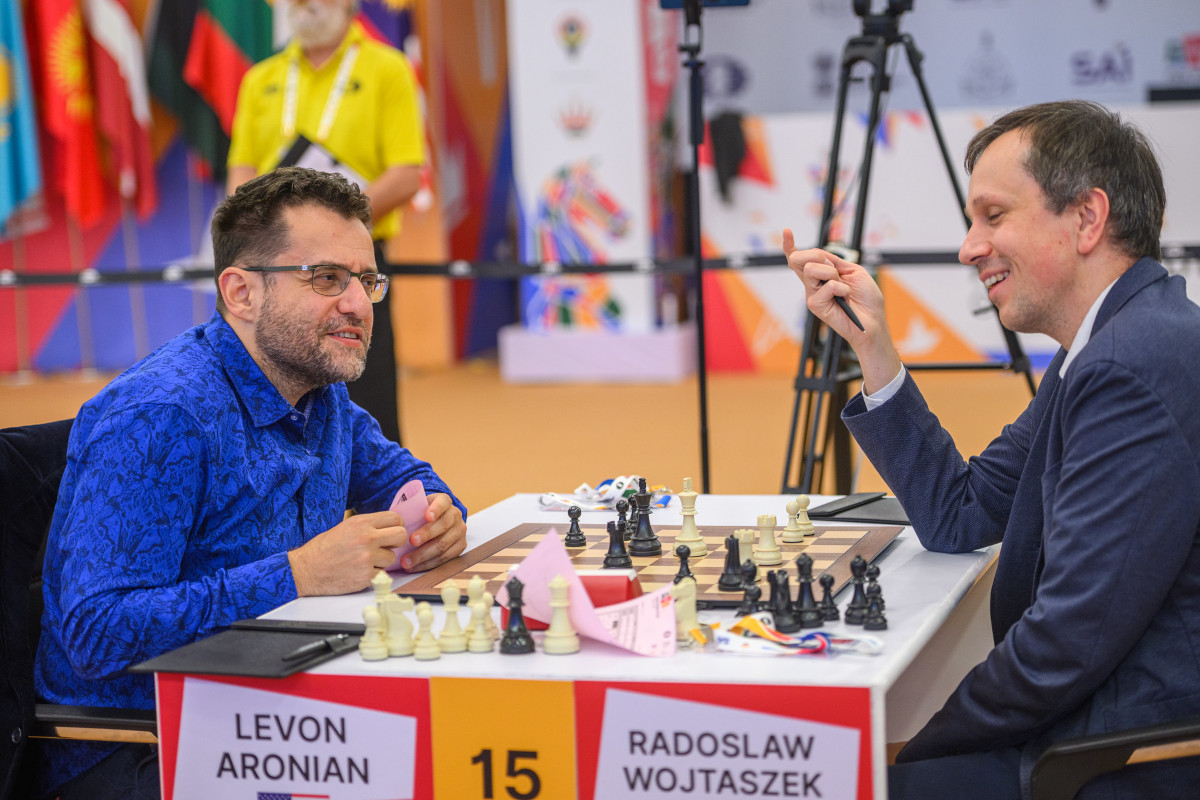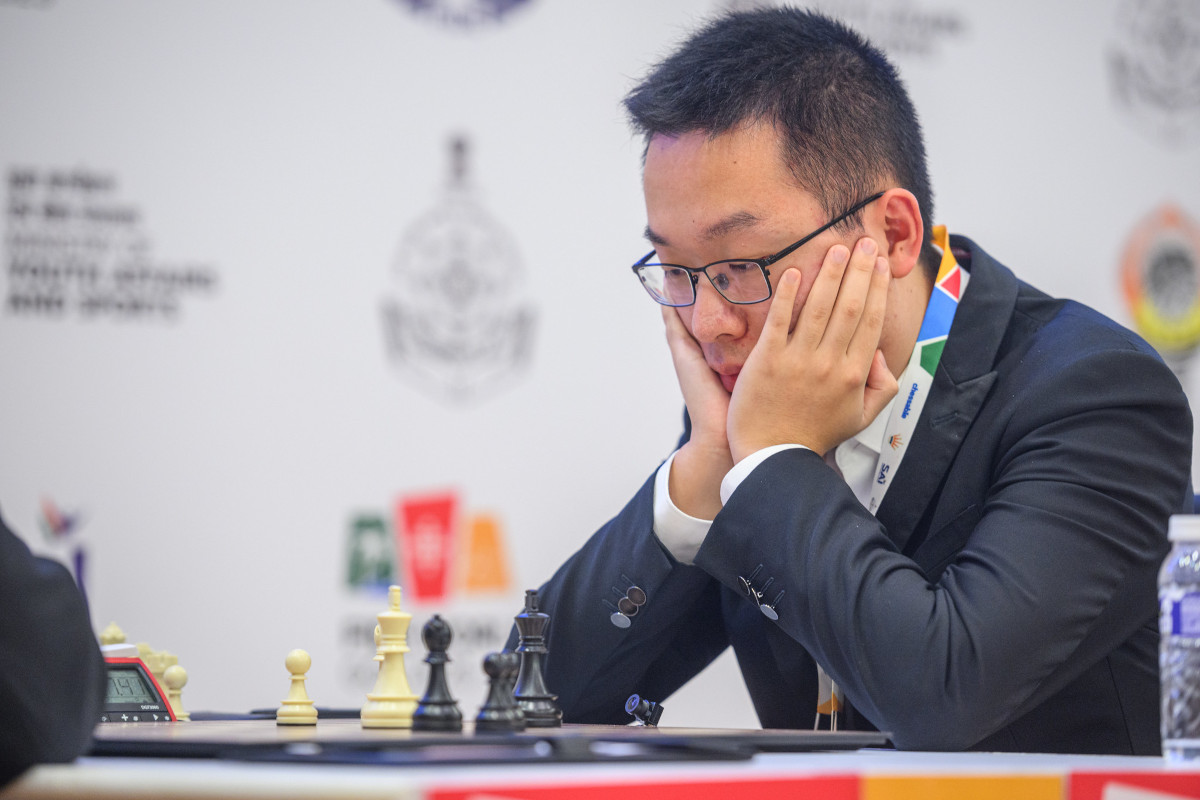Donchenko knocks out Giri and Bluebaum in consecutive rounds
The classical rematches of the round-of-32 were played on Wednesday at the FIDE World Cup in Goa. Out of the 16 matches, only 5 were decided without the need for tiebreaks. Interestingly, this round produced the same number of matches that will only be decided in tiebreaks as the previous one, despite featuring half as many matches. With the field narrowing and the stakes rising, the players’ approach has naturally become more cautious, though the day still offered several notable battles.
The five players who already secured qualification to the round-of-16 were Le Quang Liem (Vietnam, 2729), Levon Aronian (United States, 2728), Nodirbek Yakubboev (Uzbekistan, 2689), Jose Martinez (Mexico, 2644) and Alexander Donchenko (Germany, 2641).
In today’s fast-paced chess world, especially online, where blitz and rapid games dominate, the traditional approach of grinding through lines of opening theory can feel overwhelming, and even unnecessary. The real challenge? Striking the right balance in your opening preparation. How deep should you go? Where do you stop? This course is built on the timeless wisdom of my legendary coach, Chebanenko, who designed opening repertoires for his “lazy” students – not lazy in attitude, but smart in approach. His philosophy? Don’t memorise. Understand.

Le Quang Liem is already among the final sixteen in Goa | Photo: Michal Walusza
Aronian and Martinez had already taken the lead on Tuesday and only needed draws to advance. Aronian, playing black against Radoslaw Wojtaszek, opted for an active setup rather than a purely defensive one.
The Armenian-born GM even gained an edge in the middlegame before the players agreed to a draw after 35 moves of a sharp but balanced fight.

Sharing notes after a tough battle – experienced GMs Levon Aronian and Radoslaw Wojtasze | Photo: Michal Walusza
Martinez, meanwhile, neutralised Alexey Sarana’s attempts to complicate matters. Facing a Sicilian Defence, the Mexican grandmaster achieved a solid position by playing the Alapin Variation. Moreover, Martinez took over the initiative as his opponent overextended. Before the game ended by triple repetition, the Mexican representative held a clear advantage, comfortably sealing his spot in the next round.
In this insightful video course, Grandmaster David Navara shares practical advice on when to calculate deeply in a position — and just as importantly, when not to.
Free sample video: Introduction
Free sample video: Invisible moves
White is clearly better here, as Black has not been able to find a secure position for his king. Moves like 19.a4 or 19.Re1 would keep White’s big advantage – however, given the circumstances, Martinez opted for 19.Bf7+ Kd8 20.Bb3 Ke8 (the threat is Ne5-f7+), with a draw by triple repetition.

Jose Martinez happily talking about his game with Indian commentators Tania Sachdev and Harshit Raja | Photo: Michal Walusza
The remaining three players who advanced did so by winning their games on Wednesday. Le Quang Liem outplayed Karthik Venkataraman from the black side of a Nimzo-Indian Defence. Although the Indian grandmaster was eliminated, his campaign in Goa was highly commendable: as the second-lowest-rated participant still in contention, he had achieved impressive upset match victories over Aravindh Chithambaram and Bogdan-Daniel Deac in the previous rounds.
Nodirbek Yakubboev also moved forward by defeating Pranav Venkatesh, the reigning world junior champion, who has recently enjoyed strong results in Fujairah and Salamanca. Pranav, playing black, declined a likely repetition on move 25, seeking winning chances, but soon misplayed the position.
Yakubboev capitalised with precise and steady technique to convert his advantage into a full point. Find below the full game, with annotations by Karsten Müller.
If one skill decides more games, it’s calculation. Openings fade, plans change – but seeing clearly, comparing lines, and choosing with confidence wins points. In this course GM Ganguly turns calculation into a trainable skill with a structured path for any level. You won’t just solve tactics; you’ll learn how to think: where to start, which branches to explore, when to stop, and how to keep a crystal-clear mental board under pressure.
Free video sample: Introduction
Free video sample: Forcing moves

Nodirbek Yakubboev | Photo: Michal Walusza
The remaining winner of the day, Alexander Donchenko, overcame his compatriot Matthias Bluebaum in a strategic struggle arising from a Queen’s Gambit Declined. The game featured a symmetrical pawn structure, where Donchenko gradually outmanoeuvred the higher-rated player. The 61st seed in Goa, Donchenko has now eliminated both Anish Giri and Bluebaum – coincidentally, the two players who qualified for the Candidates through the Grand Swiss a couple of months ago – in successive rounds.
Donchenko will face Le Quang Liem in the round-of-16, aiming to extend his remarkable sequence of upset victories.
Find below the all-German encounter, with annotations by Johannes Fischer.

Matthias Bluebaum knows that he is in deep trouble | Photo: Michal Walusza
Several key matchups remain undecided and are set to be resolved in Thursday’s tiebreaks. The pairings promise high-level encounters likely to attract considerable attention. The following encounters are among the most anticipated clashes:
- Arjun Erigaisi v. Peter Leko
- Praggnanandhaa Rameshbabu v. Daniil Dubov
- Vincent Keymer v. Andrey Esipenko
- Wei Yi v. Parham Maghsoodloo
- Richard Rapport v. Sam Shankland

Wei Yi failed to make the most of a favourable (objectively winning) endgame against Parham Maghsoodloo on Wednesday | Photo: Michal Walusza

The Hungarian duo of Peter Leko and Richard Rapport | Photo: Michal Walusza
All games – Round 4
Replay games from all rounds at Live.ChessBase.com
EXPAND YOUR CHESS HORIZONS
Data, plans, practice – the new Opening Report In ChessBase there are always attempts to show the typical plans of an opening variation. In the age of engines, chess is much more concrete than previously thought. But amateurs in particular love openings with clear plans, see the London System. In ChessBase ’26, three functions deal with the display of plans. The new opening report examines which piece moves or pawn advances are significant for each important variation. In the reference search you can now see on the board where the pieces usually go. If you start the new Monte Carlo analysis, the board also shows the most common figure paths.
